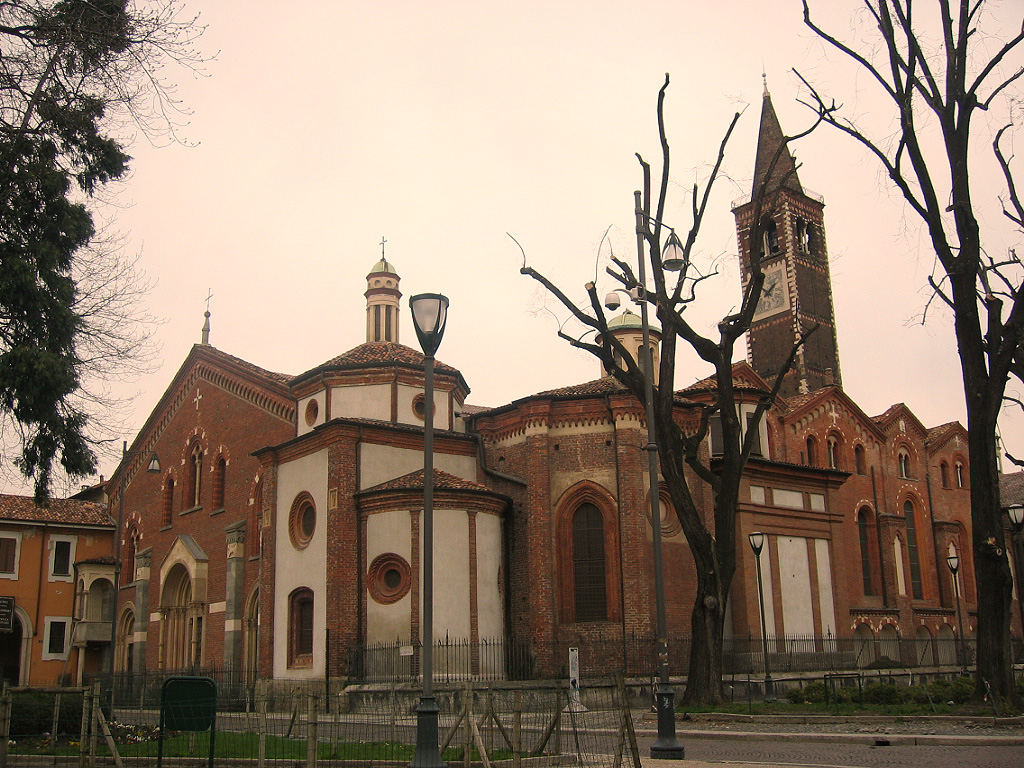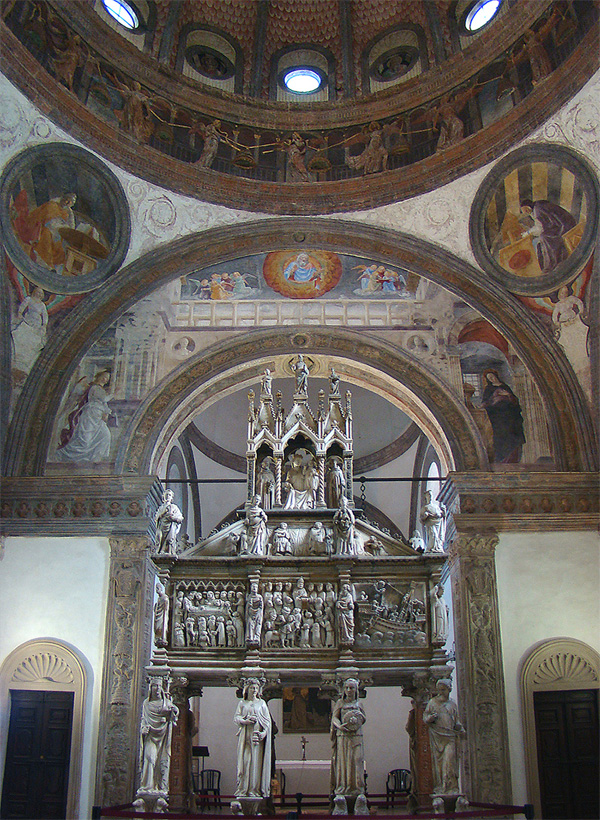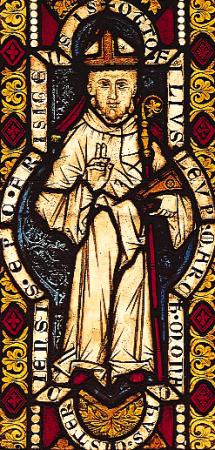|
Eustorgius I
Eustorgius I ( it, Eustorgio) was bishop of Milan from 343 to about 349. He is honoured as a Saint in both the Catholic Church and the Eastern Orthodox Church. His feast day is on the September 18. Life According to the tradition, Eustorgius was a noble Greek. He was the legate of Milan and he was elected as bishop at the death of Protasius in 343. Eustorgius traveled to Constantinople to have his election as bishop confirmed by the Emperor, and in that occasion Emperor donated to him the relics of the Three Magi which he translated from Constantinople to Milan. From 345 to 346 and from 347 to 348, he held two synods. He also began construction of churches and basilicas in Milan. Saint Athanasius called him a "defender of the faith" and mentions him as an opponent of Arianism. Saint Ambrose called him by the honorable title of "confessor", and just in such a way some verses concerning Milan in ca. 700. His name was included in the Ambrosian Rite and his cult in Milan is testif ... [...More Info...] [...Related Items...] OR: [Wikipedia] [Google] [Baidu] |
Basilica Of Sant'Eustorgio
The Basilica of Sant'Eustorgio is a church in Milan in northern Italy, which is in the Basilicas Park city park. It was for many years an important stop for pilgrims on their journey to Rome or to the Holy Land, because it was said to contain the tomb of the Three Magi or ''Three Kings''. Probably founded in the 4th century, its name refers to Eustorgius I, the bishop of Milan to whom is attributed the translation of the supposed relics of the Magi to the city from Constantinople in 344. In 1764, when an ancient pillar was removed, a Christian burial was discovered, housing coins of emperor Constans, the son of Constantine the Great. The church was later rebuilt in Romanesque style. In the 12th century, when Milan was sacked by Frederick Barbarossa, the relics of the Magi were appropriated and subsequently taken to Cologne. It was only in 1903/4 that fragments of the bones and garments were sent back to Sant'Eustorgio's. Nowadays they are in the Three Kings altar nearby the e ... [...More Info...] [...Related Items...] OR: [Wikipedia] [Google] [Baidu] |
Confessor
Confessor is a title used within Christianity in several ways. Confessor of the Faith Its oldest use is to indicate a saint who has suffered persecution and torture for the faith but not to the point of death.Beccari, Camillo. "Confessor." The Catholic Encyclopedia Vol. 4. New York: Robert Appleton Company, 1908. 8 June 2018 The term is still used that way in the . In the , it is used for any saint, as well as those who have been declared b ... [...More Info...] [...Related Items...] OR: [Wikipedia] [Google] [Baidu] |
Aegidius Gelenius
Aegidius Gelenius (10 June 1595 – 24 August 1656) was a German clergyman and historian who worked as historiographer to the Archbishop-Elector of Cologne, Ferdinand of Bavaria. He had at his disposal some earlier sources that are not in existence today, including a life of Herman of Scheda. He developed a late hatching system for heraldry but it did not gain popularity. Life Gelenius was born in Kempen and was the brother of Johannes Gelenius. He began his studies with the Jesuits in Mainz in 1614 and continued them in Italy. He spent about five years in the Collegium Germanicum in Rome doing philosophical, ecclesiastical, dogmatical and "archaeological" studies. He was consecrated in 1616 in the Lateran church and was awarded the degree Bachelor of Theology from Perugia University. In 1621, he became a canon of the St. Andreas Closter in Cologne and was promoted to the Cologne department of theology in 1623 where he obtained a licentiate degree in theology. Between 1 ... [...More Info...] [...Related Items...] OR: [Wikipedia] [Google] [Baidu] |
Otto Of Freising
Otto of Freising ( la, Otto Frisingensis; c. 1114 – 22 September 1158) was a German churchman of the Cistercian order and chronicled at least two texts which carries valuable information on the political history of his own time. He was Otto I Bishop of Freising as from 1138. Otto participated in the Second Crusade; he lived through the journey and reached Jerusalem, and later returned to Bavaria in the late 1140s, living for another decade back in Europe. Life Otto was born in Klosterneuburg as the fifth son of Leopold III, margrave of Austria, by his wife Agnes, daughter of the emperor Henry IV. By her first husband, Frederick I of Hohenstaufen, duke of Swabia, Agnes was the mother of the German king Conrad III and grandmother of the emperor Frederick I. Otto's sister, Judith or Ita, was married to Marquess William V of Montferrat. Otto was thus related to the most powerful families in Germany and northern Italy. The records of his life are scanty and the dates somewha ... [...More Info...] [...Related Items...] OR: [Wikipedia] [Google] [Baidu] |
Gesta Episcoporum Leodiensium
The ''Gesta episcoporum Leodiensium'' ("Deeds of the Bishops of Liège") is a history of the diocese of Liège written by the monk Gilles of Orval between 1247 and 1251. At about the same time, Gilles also composed an epitome of his history, the ''Gesta episcoporum Leodensium abbreviata''. It was first edited by Johannes Heller for the Monumenta Germaniae Historica in 1880."Aegidii Aureaevallensis gesta episcoporum Leodiensium", MGH ''Scriptores'', 25 (Frankfurt: 1880), 1–129. Gilles sought to continue the earlier ''gesta'' of Heriger of Lobbes and Anselm of Liège from 1048 down to 1247. As a historian, he was rather uncritical. His is the earliest account to mention any children of King Zwentibold Zwentibold (''Zventibold'', ''Zwentibald'', ''Swentiboldo'', ''Sventibaldo'', ''Sanderbald''; – 13 August 900), a member of the Carolingian dynasty, was the illegitimate son of Emperor Arnulf.Collins 1999, p. 360 In 895, his father granted h .... Notes Sources * *{{cite ... [...More Info...] [...Related Items...] OR: [Wikipedia] [Google] [Baidu] |
Gilles Of Orval
Giles of Orval (french: Gilles d'Orval; la, Aegidius Aureaevallensis) was a Cistercian monk and historian. Originally from the prince-bishopric of Liège, he lived and worked in the abbey of Orval in the archdiocese of Trier. His major work was the ''Gesta episcoporum Leodiensium'' he compiled between 1247 and 1251. It is a history of his native diocese and its bishops from 1048 until his own time. At the same time he also composed a shorter version, the ''Gesta episcoporum Leodensium abbreviata''. As a historian, Giles was rather uncritical with his sources, the most important of which were Heriger of Lobbes and Anselm of Liège Anselm of Liège (1008 – c. 1056) was a chronicler of the eleventh century of the Prince-Bishopric of Liège. Biography He was educated at the episcopal school of Liège, and became canon and dean of the cathedral, where he enjoyed the friends .... Notes Sources * * {{Authority control Historians of the Catholic Church 13th-century Latin writ ... [...More Info...] [...Related Items...] OR: [Wikipedia] [Google] [Baidu] |
Monumenta Germaniae Historica
The ''Monumenta Germaniae Historica'' (''MGH'') is a comprehensive series of carefully edited and published primary sources, both chronicle and archival, for the study of Northwestern and Central European history from the end of the Roman Empire to 1500. Despite the name, the series covers important sources for the history of many countries besides Germany, since the Society for the Publication of Sources on Germanic Affairs of the Middle Ages has included documents from many other areas subjected to the influence of Germanic tribes or rulers (Britain, Czech lands, Poland, Austria, France, Low Countries, Italy, Spain, etc.). The editor from 1826 until 1874 was Georg Heinrich Pertz (1795–1876); in 1875 he was succeeded by Georg Waitz (1813–1886). History The MGH was founded in Hanover as a private text publication society by the Prussian reformer Heinrich Friedrich Karl Freiherr vom Stein in 1819. The first volume appeared in 1826. The editor from 1826 until 1874 was Georg He ... [...More Info...] [...Related Items...] OR: [Wikipedia] [Google] [Baidu] |
Stefan Lochner
Stefan Lochner (the ''Dombild Master'' or ''Master Stefan''; c. 1410 – late 1451) was a German painter working in the late International Gothic period. His paintings combine that era's tendency toward long flowing lines and brilliant colours with the realism, virtuoso surface textures and innovative iconography of the early Northern Renaissance. Based in Cologne, a commercial and artistic hub of northern Europe, Lochner was one of the most important German painters before Albrecht Dürer. Extant works include single-panel oil paintings, devotional polyptychs and illuminated manuscripts, which often feature fanciful and blue-winged angels. Today some thirty-seven individual panels are attributed to him with confidence.Chapuis, 103 Less is known of his life. Art historians associating the Dombild Altarpiece master with the historical Stefan Lochner believe he was born in Meersburg in south-west Germany around 1410, and that he spent some of his apprenticeship in the Low Coun ... [...More Info...] [...Related Items...] OR: [Wikipedia] [Google] [Baidu] |
William Of Newburgh
William of Newburgh or Newbury ( la, Guilelmus Neubrigensis, ''Wilhelmus Neubrigensis'', or ''Willelmus de Novoburgo''. 1136 – 1198), also known as William Parvus, was a 12th-century English historian and Augustinian canon of Anglo-Saxon descent from Bridlington, East Riding of Yorkshire. William experienced the Jewish pogroms in York in the late 12th century mentioning, "the slaughter was less the work of religious zeal than of bold and covetous men who wrought the business of their own greed". William also composed a lengthy Marian exposition on the Song of Songs and three sermons on liturgical texts and Saint Alban. History of English Affairs William's major work was ''Historia rerum Anglicarum'' or ''Historia de rebus anglicis'' ("History of English Affairs"), a history of England from 1066 to 1198, written in Latin. The work is valued by historians for detailing The Anarchy under Stephen of England. It is written in an engaging fashion and still readable to this day, ... [...More Info...] [...Related Items...] OR: [Wikipedia] [Google] [Baidu] |
Relic
In religion, a relic is an object or article of religious significance from the past. It usually consists of the physical remains of a saint or the personal effects of the saint or venerated person preserved for purposes of veneration as a tangible memorial. Relics are an important aspect of some forms of Buddhism, Christianity, Islam, shamanism, and many other religions. ''Relic'' derives from the Latin ''reliquiae'', meaning "remains", and a form of the Latin verb ''relinquere'', to "leave behind, or abandon". A reliquary is a shrine that houses one or more religious relics. In classical antiquity In ancient Greece, a polis, city or Greek temple, sanctuary might claim to possess, without necessarily displaying, the remains of a venerated hero as a part of a Greek hero cult, hero cult. Other venerable objects associated with the hero were more likely to be on display in sanctuaries, such as spears, shields, or other weaponry; chariots, ships or Figurehead (object), figureheads ... [...More Info...] [...Related Items...] OR: [Wikipedia] [Google] [Baidu] |
Sarcophagus
A sarcophagus (plural sarcophagi or sarcophaguses) is a box-like funeral receptacle for a corpse, most commonly carved in stone, and usually displayed above ground, though it may also be buried. The word ''sarcophagus'' comes from the Greek σάρξ ' meaning "flesh", and φαγεῖν ' meaning "to eat"; hence ''sarcophagus'' means "flesh-eating", from the phrase ''lithos sarkophagos'' ( λίθος σαρκοφάγος), "flesh-eating stone". The word also came to refer to a particular kind of limestone that was thought to rapidly facilitate the decomposition of the flesh of corpses contained within it due to the chemical properties of the limestone itself. History of the sarcophagus Sarcophagi were most often designed to remain above ground. The earliest stone sarcophagi were used by Egyptian pharaohs of the 3rd dynasty, which reigned from about 2686 to 2613 B.C. The Hagia Triada sarcophagus is a stone sarcophagus elaborately painted in fresco; one style of later A ... [...More Info...] [...Related Items...] OR: [Wikipedia] [Google] [Baidu] |
Side View Of Saint Eustorgius Church In Milan
Side or Sides may refer to: Geometry * Edge (geometry) of a polygon (two-dimensional shape) * Face (geometry) of a polyhedron (three-dimensional shape) Places * Side (Ainis), a town of Ainis, ancient Thessaly, Greece * Side (Caria), a town of ancient Caria, Anatolia * Side (Laconia), a town of ancient Laconia, Greece * Side (Pontus), a town of ancient Pontus, Anatolia * Side, Turkey, a city in Turkey * Side, Iran, a village in Iran * Side, Gloucestershire, or Syde, a village in England Music * Side (recording), the A-side or B-side of a record * The Side, a Scottish rock band * ''Sides'' (album), a 1979 album by Anthony Phillips * ''Sides'', a 2020 album by Emily King * "Side" (song), a 2001 song by Travis * "Sides", a song by Flobots from the album ''The Circle in the Square'', 2012 * "Sides", a song by Allday from the album ''Speeding'', 2017 Teams * Side (cue sports technique) * Side, a team, in particular: ** Sports team Other uses * Side (mythology), one of three m ... [...More Info...] [...Related Items...] OR: [Wikipedia] [Google] [Baidu] |






